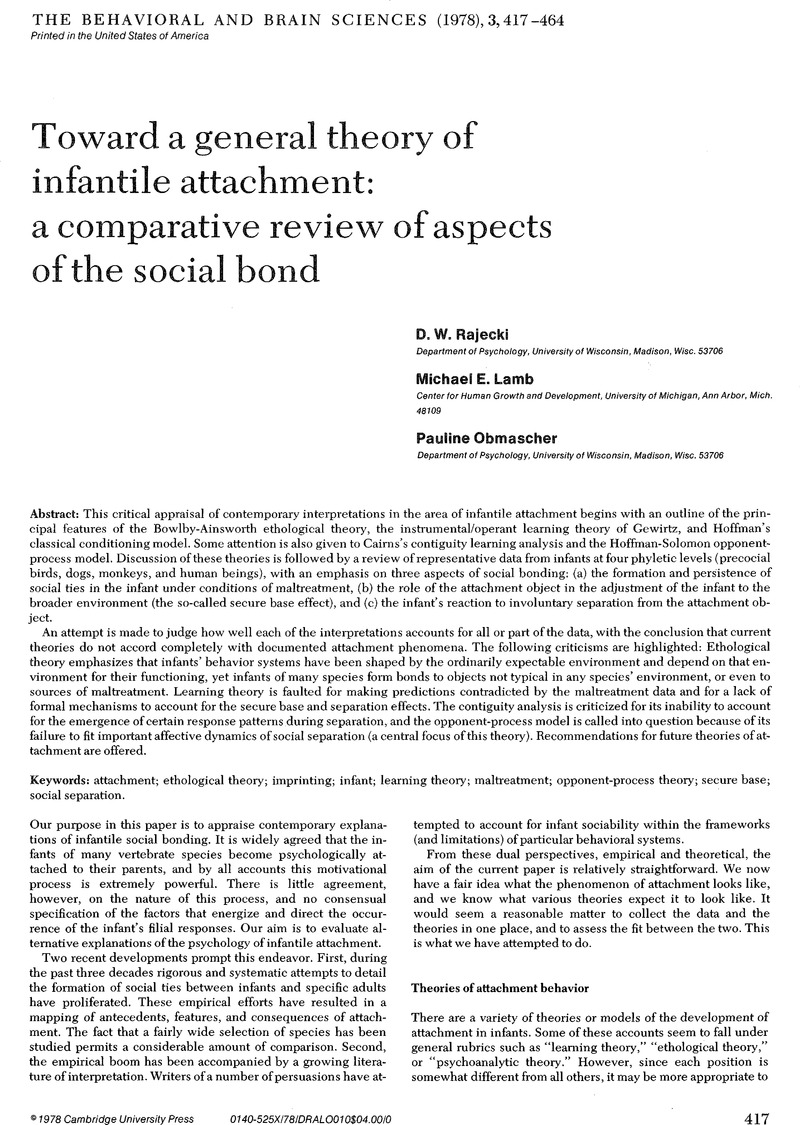Crossref Citations
This article has been cited by the following publications. This list is generated based on data provided by Crossref.
Eiserer, Leonard A.
and
Swope, Randy L.
1980.
Acquisition of behavioral control by static visual features of an imprinting object: Species generality.
Animal Learning & Behavior,
Vol. 8,
Issue. 3,
p.
481.
BOLHUIS, JOHAN J.
1991.
MECHANISMS OF AVIAN IMPRINTING: A REVIEW.
Biological Reviews,
Vol. 66,
Issue. 4,
p.
303.
Pérusse, Daniel
1992.
Attachment: A view from evolutionary biology and behavior genetics.
Behavioral and Brain Sciences,
Vol. 15,
Issue. 3,
p.
521.
Kagan, Jerome
1992.
The meanings of attachment.
Behavioral and Brain Sciences,
Vol. 15,
Issue. 3,
p.
517.
Sigman, Marian
and
Siegel, Daniel J.
1992.
The interface between the psychobiological and cognitive models of attachment.
Behavioral and Brain Sciences,
Vol. 15,
Issue. 3,
p.
523.
Kraemer, Gary W.
1992.
Psychobiological attachment theory (PAT) and psychopathology.
Behavioral and Brain Sciences,
Vol. 15,
Issue. 3,
p.
525.
Ellis, Hadyn D.
1992.
A wise child: Face perception by human neonates.
Behavioral and Brain Sciences,
Vol. 15,
Issue. 3,
p.
514.
Insel, Thomas R.
1992.
Oxytocin and the neurobiology of attachment.
Behavioral and Brain Sciences,
Vol. 15,
Issue. 3,
p.
515.
Mason, William A.
1992.
Does function imply structure?.
Behavioral and Brain Sciences,
Vol. 15,
Issue. 3,
p.
519.
Boccia, Maria L.
1992.
Refining the attachment model.
Behavioral and Brain Sciences,
Vol. 15,
Issue. 3,
p.
511.
Kraemer, Gary W.
1992.
A psychobiological theory of attachment.
Behavioral and Brain Sciences,
Vol. 15,
Issue. 3,
p.
493.
Capitanio, John P.
1992.
What do attachment objects afford?.
Behavioral and Brain Sciences,
Vol. 15,
Issue. 3,
p.
512.
Kovach, Joseph K.
1992.
Attachment and the sources of behavioral pathology.
Behavioral and Brain Sciences,
Vol. 15,
Issue. 3,
p.
518.
Salzen, Eric A.
1992.
Behavioural, aminergic and neural systems in attachment.
Behavioral and Brain Sciences,
Vol. 15,
Issue. 3,
p.
522.
Freedman, Daniel G.
1992.
The many levels of attachment.
Behavioral and Brain Sciences,
Vol. 15,
Issue. 3,
p.
515.
Jacobs, Bob
and
Raleigh, Michael J.
1992.
Attachment: How early, how far?.
Behavioral and Brain Sciences,
Vol. 15,
Issue. 3,
p.
517.
Trevarthen, Colwyn
1992.
Emotions of human infants and mothers and development of the brain.
Behavioral and Brain Sciences,
Vol. 15,
Issue. 3,
p.
524.
Eiserer, Leonard A.
1992.
Levels of explanation in theories of infant attachment.
Behavioral and Brain Sciences,
Vol. 15,
Issue. 3,
p.
513.
Nemeroff, Charles B.
and
Goodman, Sherryl H.
1992.
A new psychobiological theory of attachment:Primum non nocere.
Behavioral and Brain Sciences,
Vol. 15,
Issue. 3,
p.
520.
Svensson, Torgny H.
1992.
A psychopharmacologist's view of attachment.
Behavioral and Brain Sciences,
Vol. 15,
Issue. 3,
p.
524.


